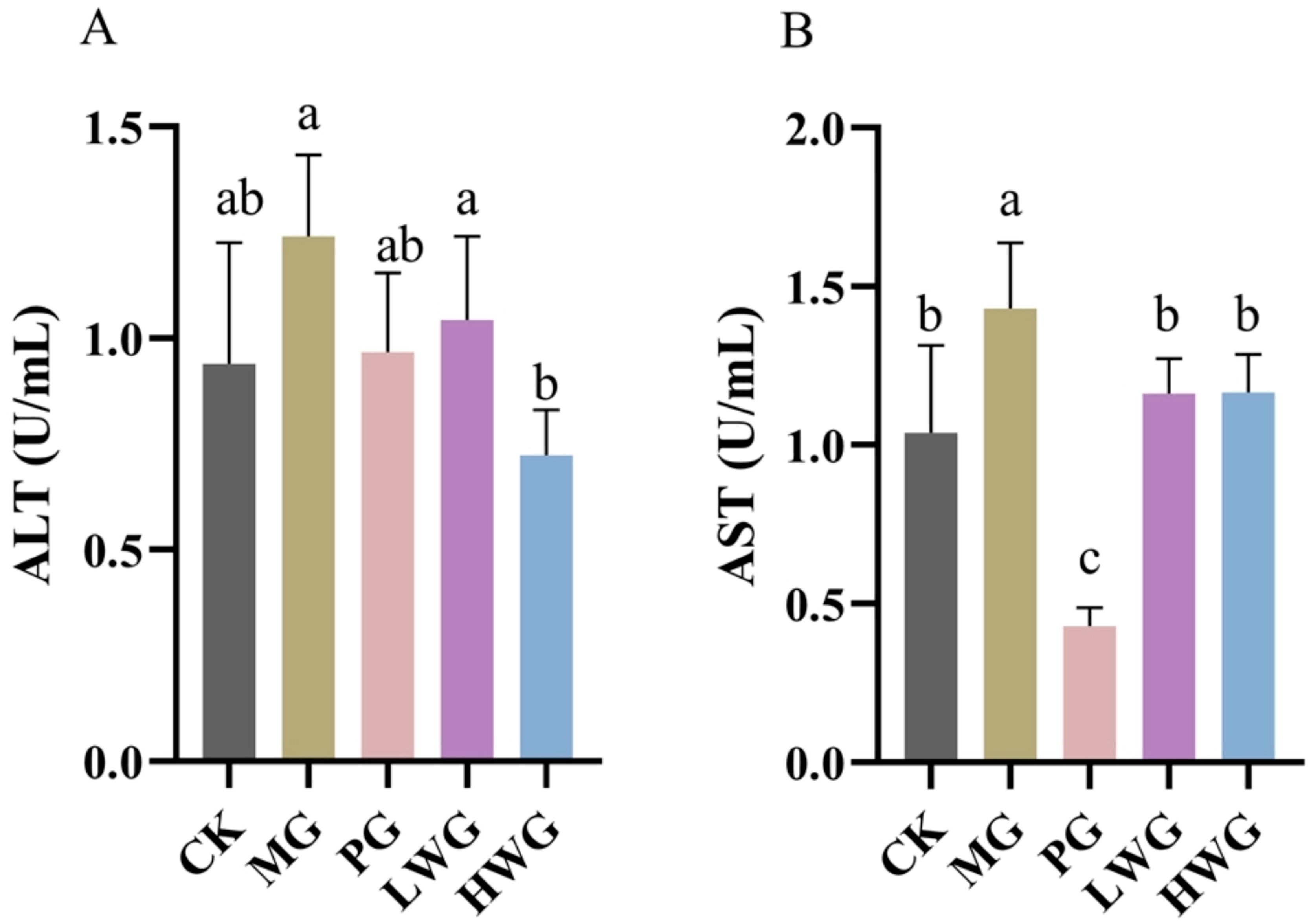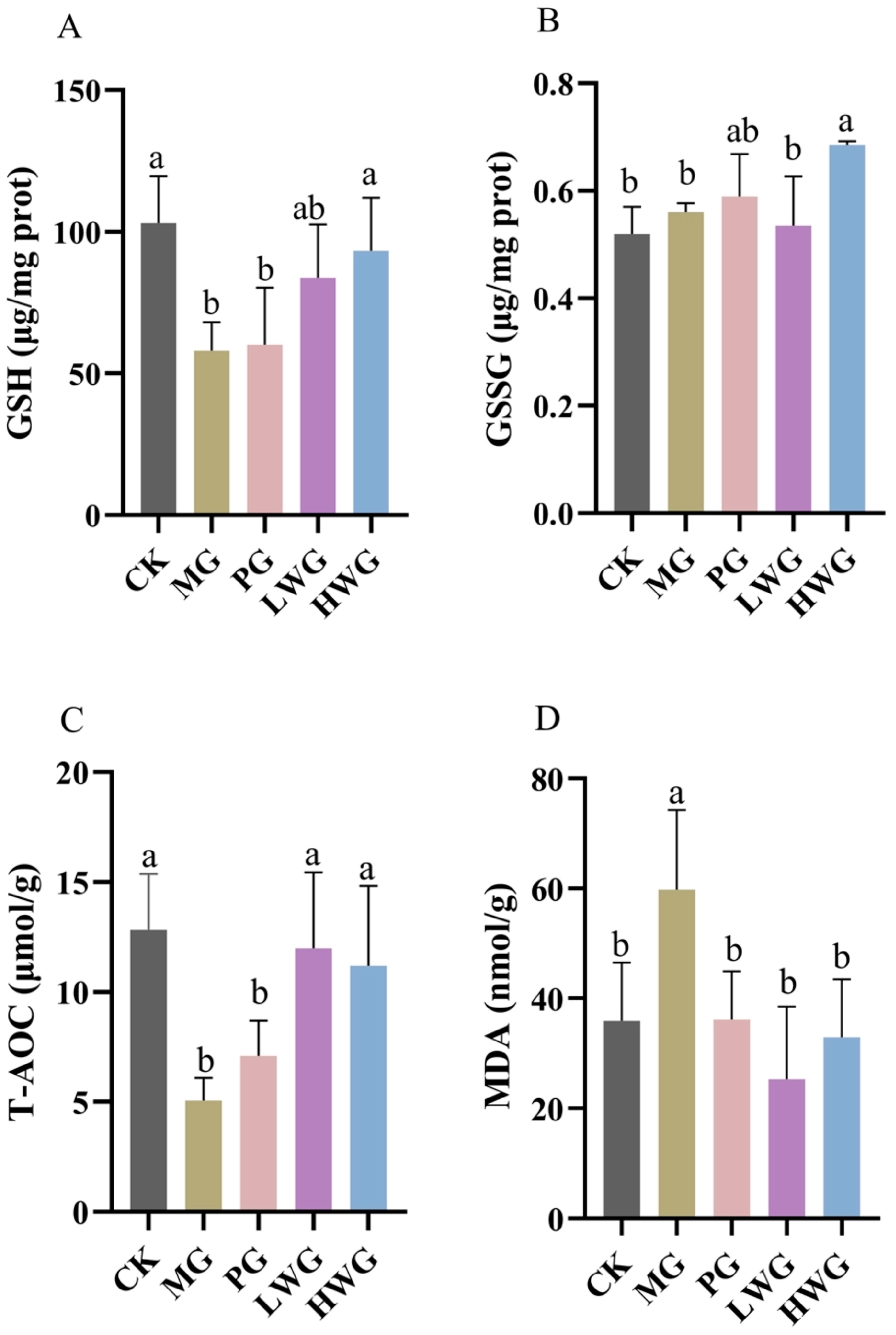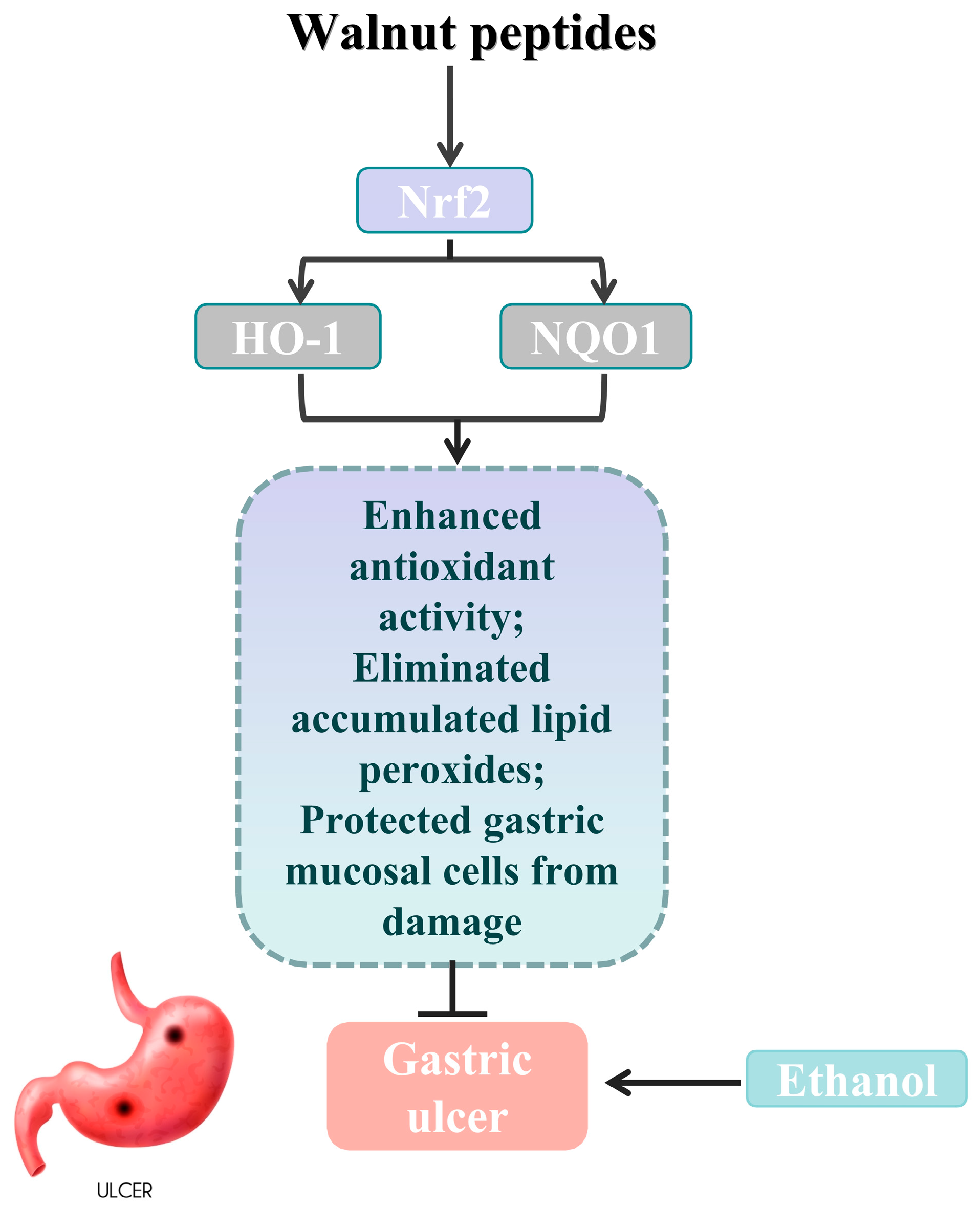The Gastroprotective Effect of Walnut Peptides: Mechanisms and Impact on Ethanol-Induced Acute Gastric Mucosal Injury in Mice
Abstract
:1. Introduction
2. Materials and Methods
2.1. Materials and Reagents
2.2. Animals and Groups
2.3. Peptide Components Analysis of Walnut Peptides Based on LC-MS/MS
2.4. Organ Index Calculation
2.5. Evaluation of Gastric Mucosal Injury
2.6. Determination of AST and ALT Levels in Serum
2.7. Measurement of Gastric Tissue Antioxidant Capacity
2.8. Measurement of Gastric Tissue Regulatory Mediator Levels
2.9. Western Blot Assay
2.10. Statistical Analysis
3. Results
3.1. Analysis of Walnut Peptide Amino Acid Sequences
3.2. The Effects of WP on Mouse Body Weight and Organ Indices
3.3. The Effects of WP on Serum ALT and AST Levels
3.4. The Impact of WP on Gastric Mucosal Tissue Pathological Changes
3.5. The Effects of WP on Gastric Tissue Oxidative Stress
3.6. The Effects of WP on Gastric Tissue Inflammation
3.7. The Effects of WP on the Protein Expression of Inflammatory Factors in Gastric Tissue
4. Discussion
5. Conclusions
Author Contributions
Funding
Institutional Review Board Statement
Informed Consent Statement
Data Availability Statement
Conflicts of Interest
References
- Haghparast, P.; Tchalikian, T.N. Alcoholic Beverages and Health Effects. In Reference Module in Biomedical Sciences; Elsevier: Amsterdam, The Netherlands, 2022; p. B978012824315200244X. ISBN 978-0-12-801238-3. [Google Scholar]
- Laine, L.; Takeuchi, K.; Tarnawski, A. Gastric Mucosal Defense and Cytoprotection: Bench to Bedside. Gastroenterology 2008, 135, 41–60. [Google Scholar] [CrossRef] [PubMed]
- Zheng, H.; Chen, Y.; Zhang, J.; Wang, L.; Jin, Z.; Huang, H.; Man, S.; Gao, W. Evaluation of Protective Effects of Costunolide and Dehydrocostuslactone on Ethanol-Induced Gastric Ulcer in Mice Based on Multi-Pathway Regulation. Chem.-Biol. Interact. 2016, 250, 68–77. [Google Scholar] [CrossRef] [PubMed]
- Wang, Y.; Su, W.; Zhang, C.; Xue, C.; Chang, Y.; Wu, X.; Tang, Q.; Wang, J. Protective Effect of Sea Cucumber (Acaudina molpadioides) Fucoidan against Ethanol-Induced Gastric Damage. Food Chem. 2012, 133, 1414–1419. [Google Scholar] [CrossRef]
- Abdoulrahman, K. Anti-Ulcer Effect of Ranunculus millefoliatus on Absolute Alcohol-Induced Stomach Ulceration. Saudi J. Biol. Sci. 2023, 30, 103711. [Google Scholar] [CrossRef] [PubMed]
- Bavishi, C.; DuPont, H.L. Systematic Review: The Use of Proton Pump Inhibitors and Increased Susceptibility to Enteric Infection. Aliment. Pharmacol. Ther. 2011, 34, 1269–1281. [Google Scholar] [CrossRef]
- Ye, H.-Y.; Shang, Z.-Z.; Zhang, F.-Y.; Zha, X.-Q.; Li, Q.-M.; Luo, J.-P. Dendrobium huoshanense Stem Polysaccharide Ameliorates Alcohol-Induced Gastric Ulcer in Rats through Nrf2-Mediated Strengthening of Gastric Mucosal Barrier. Int. J. Biol. Macromol. 2023, 236, 124001. [Google Scholar] [CrossRef] [PubMed]
- Lam, J.R.; Schneider, J.L.; Zhao, W.; Corley, D.A. Proton Pump Inhibitor and Histamine 2 Receptor Antagonist Use and Vitamin B12 Deficiency. JAMA 2013, 310, 2435. [Google Scholar] [CrossRef]
- Deshpande, A.; Pasupuleti, V.; Thota, P.; Pant, C.; Mapara, S.; Hassan, S.; Rolston, D.D.K.; Sferra, T.J.; Hernandez, A.V. Acid-Suppressive Therapy Is Associated with Spontaneous Bacterial Peritonitis in Cirrhotic Patients: A Meta-Analysis: Acid-Suppressive Therapy and SBP. J. Gastroenterol. Hepatol. 2013, 28, 235–242. [Google Scholar] [CrossRef]
- Al-Sayed, E.; El-Naga, R.N. Protective Role of Ellagitannins from Eucalyptus citriodora against Ethanol-Induced Gastric Ulcer in Rats: Impact on Oxidative Stress, Inflammation and Calcitonin-Gene Related Peptide. Phytomedicine 2015, 22, 5–15. [Google Scholar] [CrossRef]
- Lin, Y.; Lv, Y.; Mao, Z.; Chen, X.; Chen, Y.; Zhu, B.; Yu, Y.; Ding, Z.; Zhou, F. Polysaccharides from Tetrastigma hemsleyanum Diels et Gilg Ameliorated Inflammatory Bowel Disease by Rebuilding the Intestinal Mucosal Barrier and Inhibiting Inflammation through the SCFA-GPR41/43 Signaling Pathway. Int. J. Biol. Macromol. 2023, 250, 126167. [Google Scholar] [CrossRef]
- Bao, X.; Wu, J. Impact of Food-Derived Bioactive Peptides on Gut Function and Health. Food Res. Int. 2021, 147, 110485. [Google Scholar] [CrossRef]
- Yu, L.; Li, R.; Liu, W.; Zhou, Y.; Li, Y.; Qin, Y.; Chen, Y.; Xu, Y. Protective Effects of Wheat Peptides against Ethanol-Induced Gastric Mucosal Lesions in Rats: Vasodilation and Anti-Inflammation. Nutrients 2020, 12, 2355. [Google Scholar] [CrossRef]
- Gu, M.; Chen, H.-P.; Zhao, M.-M.; Wang, X.; Yang, B.; Ren, J.-Y.; Su, G.-W. Identification of Antioxidant Peptides Released from Defatted Walnut (Juglans sigillata Dode) Meal Proteins with Pancreatin. LWT—Food Sci. Technol. 2015, 60, 213–220. [Google Scholar] [CrossRef]
- Sze-Tao, K.W.C.; Sathe, S.K. Walnuts (Juglans regia L): Proximate Composition, Protein Solubility, Protein Amino Acid Composition and Proteinin Vitro Digestibility. J. Sci. Food Agric. 2000, 80, 1393–1401. [Google Scholar] [CrossRef]
- Feng, Y.; Wang, Z.; Chen, J.; Li, H.; Wang, Y.; Ren, D.-F.; Lu, J. Separation, Identification, and Molecular Docking of Tyrosinase Inhibitory Peptides from the Hydrolysates of Defatted Walnut (Juglans regia L.) Meal. Food Chem. 2021, 353, 129471. [Google Scholar] [CrossRef]
- Qi, Y.; Wu, D.; Fang, L.; Leng, Y.; Wang, X.; Liu, C.; Liu, X.; Wang, J.; Min, W. Anti-Inflammatory Effect of Walnut-Derived Peptide via the Activation of Nrf2/Keap1 Pathway against Oxidative Stress. J. Funct. Foods 2023, 110, 105839. [Google Scholar] [CrossRef]
- Vu, D.C.; Vo, P.H.; Coggeshall, M.V.; Lin, C.-H. Identification and Characterization of Phenolic Compounds in Black Walnut Kernels. J. Agric. Food Chem. 2018, 66, 4503–4511. [Google Scholar] [CrossRef]
- Wang, F.; Pu, C.; Liu, M.; Li, R.; Sun, Y.; Tang, W.; Sun, Q.; Tian, Q. Fabrication and Characterization of Walnut Peptides-Loaded Proliposomes with Three Lyoprotectants: Environmental Stabilities and Antioxidant/Antibacterial Activities. Food Chem. 2022, 366, 130643. [Google Scholar] [CrossRef]
- Xu, X.; Ding, Y.; Liu, M.; Zhang, X.; Wang, D.; Pan, Y.; Ren, S.; Liu, X. Neuroprotective Mechanisms of Defatted Walnut Powder against Scopolamine-Induced Alzheimer’s Disease in Mice Revealed through Metabolomics and Proteomics Analyses. J. Ethnopharmacol. 2024, 319, 117107. [Google Scholar] [CrossRef]
- Wang, J.; Wu, T.; Fang, L.; Liu, C.; Liu, X.; Li, H.; Shi, J.; Li, M.; Min, W. Anti-Diabetic Effect by Walnut (Juglans mandshurica Maxim.)-Derived Peptide LPLLR through Inhibiting α-Glucosidase and α-Amylase, and Alleviating Insulin Resistance of Hepatic HepG2 Cells. J. Funct. Foods 2020, 69, 103944. [Google Scholar] [CrossRef]
- Huang, Y.; Chen, S.; Yao, Y.; Wu, N.; Xu, M.; Du, H.; Zhao, Y.; Tu, Y. Ovotransferrin Alleviated Acute Gastric Mucosal Injury in BALB/c Mice Caused by Ethanol. Food Funct. 2023, 14, 305–318. [Google Scholar] [CrossRef]
- Wu, J.-Z.; Liu, Y.-H.; Liang, J.-L.; Huang, Q.-H.; Dou, Y.-X.; Nie, J.; Zhuo, J.-Y.; Wu, X.; Chen, J.-N.; Su, Z.-R.; et al. Protective Role of β-Patchoulene from Pogostemon cablin against Indomethacin-Induced Gastric Ulcer in Rats: Involvement of Anti-Inflammation and Angiogenesis. Phytomedicine 2018, 39, 111–118. [Google Scholar] [CrossRef]
- Arab, H.H.; Salama, S.A.; Eid, A.H.; Kabel, A.M.; Shahin, N.N. Targeting MAPKs, NF-κB, and PI3K/AKT Pathways by Methyl Palmitate Ameliorates Ethanol-induced Gastric Mucosal Injury in Rats. J. Cell. Physiol. 2019, 234, 22424–22438. [Google Scholar] [CrossRef]
- Amirshahrokhi, K.; Khalili, A.-R. The Effect of Thalidomide on Ethanol-Induced Gastric Mucosal Damage in Mice: Involvement of Inflammatory Cytokines and Nitric Oxide. Chem.-Biol. Interact. 2015, 225, 63–69. [Google Scholar] [CrossRef]
- Zhang, J.; Lu, D.-Y.; Yuan, Y.; Chen, J.; Yi, S.; Chen, B.; Zhao, X. Liubao Insect Tea Polyphenols Prevent HCl/Ethanol Induced Gastric Damage through Its Antioxidant Ability in Mice. RSC Adv. 2020, 10, 4984–4995. [Google Scholar] [CrossRef]
- Pal, S.; Bhattacharjee, A.; Mukherjee, S.; Bhattacharya, K.; Mukherjee, S.; Khowala, S. Effect of Alocasia indica Tuber Extract on Reducing Hepatotoxicity and Liver Apoptosis in Alcohol Intoxicated Rats. BioMed Res. Int. 2014, 2014, 349074. [Google Scholar] [CrossRef]
- Jing, Y.; Hu, J.; Zhang, Y.; Sun, J.; Guo, J.; Zheng, Y.; Zhang, D.; Wu, L. Structural Characterization and Preventive Effect on Alcoholic Gastric Mucosa and Liver Injury of a Novel Polysaccharide from Dendrobium officinale. Nat. Prod. Res. 2022, 1–8. [Google Scholar] [CrossRef]
- Yoo, J.-H.; Park, E.-J.; Kim, S.H.; Lee, H.-J. Gastroprotective Effects of Fermented Lotus Root against Ethanol/HCl-Induced Gastric Mucosal Acute Toxicity in Rats. Nutrients 2020, 12, 808. [Google Scholar] [CrossRef]
- Valcheva-Kuzmanova, S.; Marazova, K.; Krasnaliev, I.; Galunska, B.; Borisova, P.; Belcheva, A. Effect of Aronia melanocarpa Fruit Juice on Indomethacin-Induced Gastric Mucosal Damage and Oxidative Stress in Rats. Exp. Toxicol. Pathol. 2005, 56, 385–392. [Google Scholar] [CrossRef]
- Nisha, S.; Bettahalli Shivamallu, A.; Prashant, A.; Yadav, M.K.; Gujjari, S.K.; Shashikumar, P. Role of Nonsurgical Periodontal Therapy on Leptin Levels and Total Antioxidant Capacity in Chronic Generalised Periodontitis Patients—A Clinical Trial. J. Oral Biol. Craniofacial Res. 2022, 12, 68–73. [Google Scholar] [CrossRef]
- Kim, H.-G. Chunggan Extract, a Traditional Herbal Formula, Ameliorated Alcohol-Induced Hepatic Injury in Rat Model. WJG 2014, 20, 15703. [Google Scholar] [CrossRef] [PubMed]
- Yang, X.; Yang, L.; Pan, D.; Liu, H.; Xia, H.; Wang, S.; Sun, G. Wheat Peptide Protects against Ethanol-Induced Gastric Mucosal Damage through Downregulation of TLR4 and MAPK. J. Funct. Foods 2020, 75, 104271. [Google Scholar] [CrossRef]
- Xie, L.; Wu, Y.; Fan, Z.; Liu, Y.; Zeng, J. Astragalus Polysaccharide Protects Human Cardiac Microvascular Endothelial Cells from Hypoxia/Reoxygenation Injury: The Role of PI3K/AKT, Bax/Bcl-2 and Caspase-3. Mol. Med. Rep. 2016, 14, 904–910. [Google Scholar] [CrossRef] [PubMed]
- Chen, W.; Wu, D.; Jin, Y.; Li, Q.; Liu, Y.; Qiao, X.; Zhang, J.; Dong, G.; Li, Z.; Li, T.; et al. Pre-Protective Effect of Polysaccharides Purified from Hericium erinaceus against Ethanol-Induced Gastric Mucosal Injury in Rats. Int. J. Biol. Macromol. 2020, 159, 948–956. [Google Scholar] [CrossRef]
- Jeon, Y.-D.; Lee, J.-H.; Lee, Y.-M.; Kim, D.-K. Puerarin Inhibits Inflammation and Oxidative Stress in Dextran Sulfate Sodium-Induced Colitis Mice Model. Biomed. Pharmacother. 2020, 124, 109847. [Google Scholar] [CrossRef]
- Dejban, P.; Eslami, F.; Rahimi, N.; Takzare, N.; Jahansouz, M.; Dehpour, A.R. Involvement of Nitric Oxide Pathway in the Anti-Inflammatory Effect of Modafinil on Indomethacin-, Stress-, and Ethanol-Induced Gastric Mucosal Injury in Rat. Eur. J. Pharmacol. 2020, 887, 173579. [Google Scholar] [CrossRef]
- Filaly, H.E.; Outlioua, A.; Medyouf, H.; Guessous, F.; Akarid, K. Targeting IL-1β in Patients with Advanced Helicobacter pylori Infection: A Potential Therapy for Gastric Cancer. Future Microbiol. 2022, 17, 633–641. [Google Scholar] [CrossRef]
- Guo, T.; Qian, J.-M.; Zhao, Y.-Q.; Li, X.-B.; Zhang, J.-Z. Effects of IL-1β on the Proliferation and Apoptosis of Gastric Epithelial Cells and Acid Secretion from Isolated Rabbit Parietal Cells. Mol. Med. Rep. 2013, 7, 299–305. [Google Scholar] [CrossRef]
- Kan, J.; Hood, M.; Burns, C.; Scholten, J.; Chuang, J.; Tian, F.; Pan, X.; Du, J.; Gui, M. A Novel Combination of Wheat Peptides and Fucoidan Attenuates Ethanol-Induced Gastric Mucosal Damage through Anti-Oxidant, Anti-Inflammatory, and Pro-Survival Mechanisms. Nutrients 2017, 9, 978. [Google Scholar] [CrossRef]
- Bhattacharyya, A.; Chattopadhyay, R.; Mitra, S.; Crowe, S.E. Oxidative Stress: An Essential Factor in the Pathogenesis of Gastrointestinal Mucosal Diseases. Physiol. Rev. 2014, 94, 329–354. [Google Scholar] [CrossRef]
- Chen, J.; Zhang, J.; Chen, T.; Bao, S.; Li, J.; Wei, H.; Hu, X.; Liang, Y.; Liu, F.; Yan, S. Xiaojianzhong Decoction Attenuates Gastric Mucosal Injury by Activating the P62/Keap1/Nrf2 Signaling Pathway to Inhibit Ferroptosis. Biomed. Pharmacother. 2022, 155, 113631. [Google Scholar] [CrossRef] [PubMed]






| Peptide Sequence | Observed m/z | Score | Scan Time | Protein Name | Intensity |
|---|---|---|---|---|---|
| EIDIGVPDEVGRL | 706.372 | 490.0 | 48.0578 | A0A2I4EK72 | 60,222,000 |
| DLAPTHPIRL | 566.827 | 474.2 | 29.0392 | A0A2I4EB92 | 22,166,000 |
| LDRLIPVLE | 534.326 | 466.0 | 45.2099 | A0A2I4EGJ3 | 45,179,000 |
| SVIQH | 625.331 | 431.2 | 7.1603 | A0A2I4FTY2 | 40,419,000 |
| NTGSPITVPVGR | 599.334 | 428.9 | 25.3499 | A0A2I4GH77 | 25,614,000 |
| SKRPTF | 368.211 | 428.9 | 8.6987 | A0A2I4EFN4 | 81,398,000 |
| DREIDIGVPDEVGRL | 841.940 | 422.2 | 43.2557 | A0A2I4EK72 | 13,398,000 |
| RDENEKL | 452.230 | 420.2 | 7.1808 | A0A2I4E5L6 | 71,960,000 |
| Group | Liver Index (mg/g) | Kidney Index (mg/g) | Spleen Index (mg/g) | Gastric Index (mg/g) | Starting Weight (g) | Final Weight (g) |
|---|---|---|---|---|---|---|
| CK | 39.43 ± 2.32 b | 12.17 ± 1.41 ab | 29.29 ± 1.50 a | 7.85 ± 1.82 a | 39.05 ± 0.86 a | 43.80 ± 2.04 a |
| MG | 42.81 ± 1.96 a | 11.95 ± 1.19 ab | 35.28 ± 2.16 a | 9.36 ± 1.73 a | 38.32 ± 1.15 a | 42.25 ± 1.97 a |
| PG | 43.48 ± 3.65 a | 13.41 ± 2.97 a | 28.25 ± 2.26 a | 8.67 ± 2.43 a | 40.07 ± 1.61 a | 44.43 ± 2.22 a |
| LWG | 42.15 ± 3.10 a | 11.61 ± 1.31 b | 25.38 ± 0.79 a | 8.92 ± 1.24 a | 38.93 ± 2.41 a | 43.97 ± 2.51 a |
| HWG | 42.08 ± 2.95 a | 11.87 ± 1.10 ab | 24.40 ± 0.62 a | 8.99 ± 1.91 a | 39.47 ± 1.69 a | 44.53 ± 1.11 a |
Disclaimer/Publisher’s Note: The statements, opinions and data contained in all publications are solely those of the individual author(s) and contributor(s) and not of MDPI and/or the editor(s). MDPI and/or the editor(s) disclaim responsibility for any injury to people or property resulting from any ideas, methods, instructions or products referred to in the content. |
© 2023 by the authors. Licensee MDPI, Basel, Switzerland. This article is an open access article distributed under the terms and conditions of the Creative Commons Attribution (CC BY) license (https://creativecommons.org/licenses/by/4.0/).
Share and Cite
Yuan, Y.; Wang, X.; Wang, Y.; Liu, Y.; Zhao, L.; Zhao, L.; Cai, S. The Gastroprotective Effect of Walnut Peptides: Mechanisms and Impact on Ethanol-Induced Acute Gastric Mucosal Injury in Mice. Nutrients 2023, 15, 4866. https://doi.org/10.3390/nu15234866
Yuan Y, Wang X, Wang Y, Liu Y, Zhao L, Zhao L, Cai S. The Gastroprotective Effect of Walnut Peptides: Mechanisms and Impact on Ethanol-Induced Acute Gastric Mucosal Injury in Mice. Nutrients. 2023; 15(23):4866. https://doi.org/10.3390/nu15234866
Chicago/Turabian StyleYuan, Yutong, Xinyi Wang, Yumeng Wang, Yaqi Liu, Liang Zhao, Lei Zhao, and Shengbao Cai. 2023. "The Gastroprotective Effect of Walnut Peptides: Mechanisms and Impact on Ethanol-Induced Acute Gastric Mucosal Injury in Mice" Nutrients 15, no. 23: 4866. https://doi.org/10.3390/nu15234866
APA StyleYuan, Y., Wang, X., Wang, Y., Liu, Y., Zhao, L., Zhao, L., & Cai, S. (2023). The Gastroprotective Effect of Walnut Peptides: Mechanisms and Impact on Ethanol-Induced Acute Gastric Mucosal Injury in Mice. Nutrients, 15(23), 4866. https://doi.org/10.3390/nu15234866









